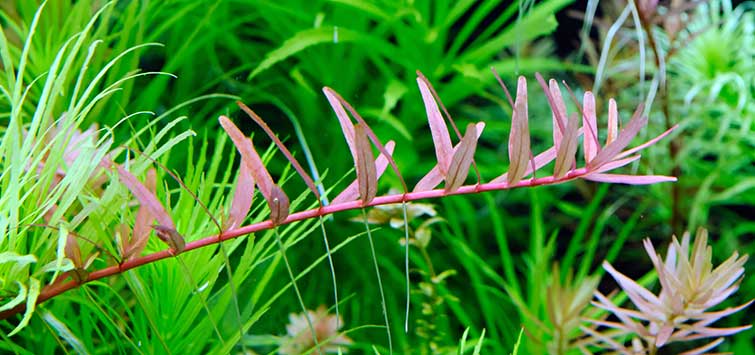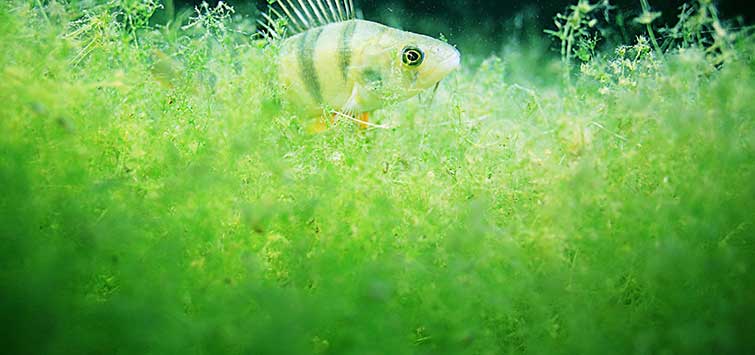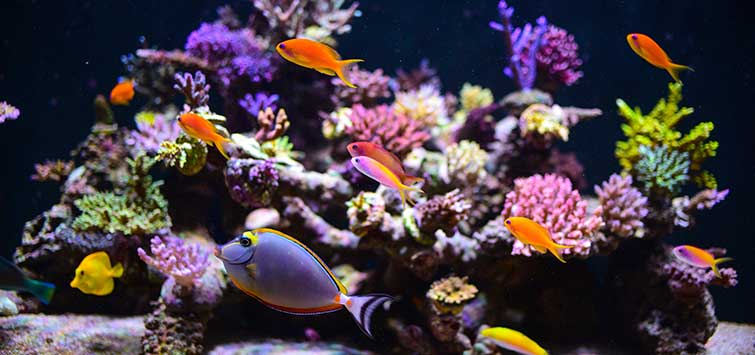Fertilizers in the Nature Aquarium
Author: Takashi Amano
Liquid fertilizers and nutritive substrates are essential to growing healthy and beautiful aquatic plants in the Nature Aquarium layout.
In the Nature Aquarium, many types of aquatic plants are used to create a layout. Each type of aquatic plant has its own characteristic mode of life, and the way that it grows and takes up nutrients is different from the others. For example, some plants such as those in the genus Cryptocoryne actively absorb nutrients from the roots, while some plants such as Riccia and stem plants absorb them from the surface of their leaves.
The ability of the latter to absorb nutrients through the leaf surface is much more developed than that of terrestrial plants. This is a very effective means of obtaining nutrients for many aquatic plants in the submersed state, with leaves that grow underwater. Taking this into account, proper liquid fertilizers are added to aquariums in the Nature Aquarium style.
Feeding Aquatic Plants
Before going into the specific method of adding nutrients, let’s think about what substances are needed for aquatic plants to grow. First, carbon, which is essential for developing the body of a plant, is absorbed mainly in the form of CO2 and turned into glucose through photosynthesis. In the case of an aquatic plant layout, carbon is supplied to aquatic plants by slowly injecting highly pure CO2 into an aquarium and dissolving it into the water.
In addition, nitrogen, phosphorus and potassium are also required in relatively large amounts for plant growth. They form important materials such as amino acids and lipids to develop cells. Of these nutrients, nitrogen and phosphorus tend to become excessive in an aquarium where fish are kept, since they are also supplied by fish’s waste and uneaten food. On the other hand, potassium tends to be in short supply. Therefore, plants grow more healthily if potassium is supplemented by itself.
Besides these substances, trace elements such as iron and magnesium are also essential for growing healthy aquatic plants. Although trace elements are replenished through water changes, both by those elements contained in the tap water and also those dissolved into the water column from substrate materials, supplementing them with liquid fertilizer is an effective way to ensure a steady supply. Therefore, as a general rule in the Nature Aquarium, liquid fertilizer containing potassium and trace elements is added daily.
Liquid Fertilizers
It would be ideal to deliver liquid fertilizer little by little, constantly as with a hospital IV drip, to replenish just the amount used by aquatic plants. However, because this is difficult to accomplish in actuality, it is more practical to add a day’s amount all at once in the morning when the light is turned on. Based on my experience, aquatic plants grow well when a proper amount of liquid fertilizer is added once a day in this manner.
In addition, although there is a prescribed dose for liquid fertilizer that serves as a guideline, in actual practice the amount of liquid fertilizer added to the aquarium needs to be adjusted based on the type and the volume of aquatic plants and their conditions. If aquatic plants are not yet growing fast right after planting, they do not need a large amount of nutrients. On the contrary, an aquarium where Riccia and stem plants are growing densely and taking up nutrients actively will require a larger amount of nutrients.
The composition of the necessary nutrients may change depending on the condition of an aquarium or the aquatic plants within. Therefore, in the Nature Aquarium the amount of liquid fertilizer may be doubled or tripled according to the growth of aquatic plants, and the type of liquid fertilizer is changed depending on the length of time after the initial planting and the condition of the aquatic plants.
To be more specific, liquid fertilizer containing well balanced trace elements is added right after planting. The liquid fertilizer with trace elements rich in iron is used for the period when aquatic plants are growing rapidly. The fertilizer containing potassium in addition to trace is used for the period more than one year after the initial planting when the growth of aquatic plants starts to stagnate. Additionally, a special liquid fertilizer that contains nitrogen and phosphorus may be used depending on the condition of an aquarium. However, in this case we must watch out for an algae outbreak. Liquid fertilizer encourages not only the growth of aquatic plants but also the growth of algae as well.
Nutritive Substrates
So far I have explained about liquid fertilizers. However, I do not supply all the nutrients that aquatic plants need with liquid fertilizers alone in actual practice. The basic method to set up the substrate is to lay sand containing nutrients first and place a natural black soil on top. The nutrients that leach out from the substrate are also absorbed by aquatic plants.
The nutrients from the substrate are especially beneficial for rooted rosette-type plants such as Cryptocoryne and Echinodorus, as well as plants like Glossostigma, cobra grass, and hair grass, which spread over the substrate. These plants do not grow well in gravel or sand that does not contain nutrients no matter how much liquid fertilizer is added. If these plants do not grow well, the composition of the substrate should be improved; adding liquid fertilizers indiscriminately will not improve their growth.
If aquatic plants start to grow poorly in a nutrient-deficient substrate that has been maintained over a long time, the substrate should be enriched with solid pelleted “nutrient-stick” type fertilizers that are placed directly into the substrate. When liquid fertilizers are used in combination with the nutrients in the substrate, aquatic plants grow healthily and beautifully, creating a beautiful Nature Aquarium aquascape.
DATA
Aquarium: Cube Garden Clear, W120 x D45 x H45 (cm)
Lighting: NA lamp 20W x 12 units, turned on for 10 hours per day
Filter: Super Jet Filter ES-1200 (Bio Rio, NA Carbon)
Substrate: Rio Negro Sand, Aqua Soil Amazonia, Power Sand Special M, Bacter 100, Clear Super, Tourmaline BC, Penac W/for Aquarium, Penac P
CO2: Pollen Glass Beetle Series 40 mm, 3 bubbles per second via CO2 Beetle Counter (using Tower/20)
Aeration: 14 hours after the light is turned off using Lily Pipe P-4
Additives: Brighty K; Green Brighty STEP2; ECA
Water change: 1/3 once a week
Water quality: Temperature 24ºC, pH 6.8, TH 20 mg/l
Aquatic Plants: Blyxa aubertii, Vallisneria nana, Isoetes japonica, Eleocharis vivipara, Echinodorus angustifolius, Cryptocoryne petchii, Cryptocoryne wendtii “Mi Oya,” Cryptocoryne wendtii “green,”Cryptocoryne balansae, Anubias barteri var. nana “narrow,” Microsorium sp., Bolbitis heudelotii, Fontinalis antipyretica
Aquatic Animals: Trigonostigma hengeli, Otocinclus sp., Crossocheilus siamensis, Caridina japonica

.png?h=595&iar=0&w=2781&hash=5FD5E69473BCC22199FBFA2FB71B6033)



